Implementing an omnichannel strategy is about offering an interwoven customer experience across multiple touchpoints. If missing, you are likely to sever ties with your customers.
Nowadays, businesses are expected to be available to customers in their desired manner, anywhere, and anytime. It is similar to moving in a never-ending circle of touchpoints, without deviating from the loop.
Here are some key parameters that work in collaboration to create a successful omnichannel strategy:
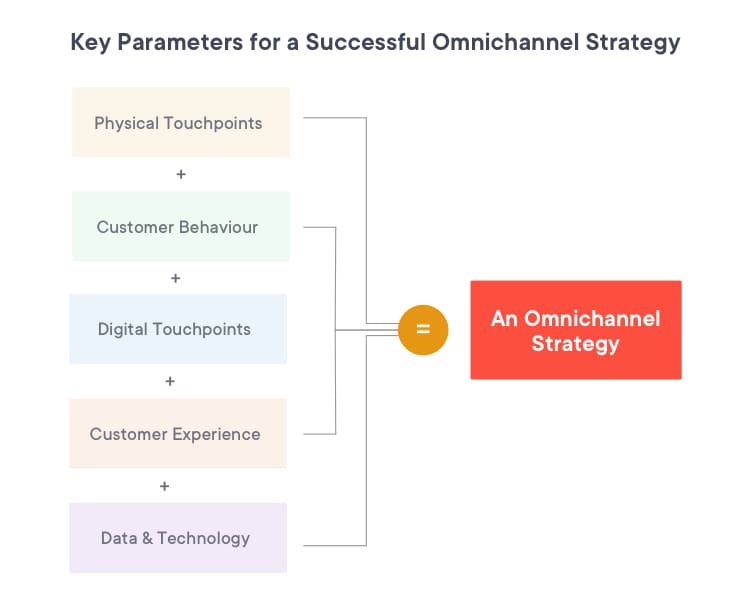
What is the Difference Between Omnichannel and Multichannel?
There are multiple touchpoints and mediums of purchase, i.e., a buyer can purchase through a brick-and-mortar store, social media platforms, website, or an app.
Earlier, these single channels were independent, i.e., if a buyer shopped from a brick-and-mortar store, the digital platform for the same brand didn’t know about the purchase, and vice-versa. This is a multi-channel strategy.
On the other hand, in the omnichannel approach, all the multiple channels are interlinked. All the channels involved ensure that the data is freely exchanged to communicate with the customer through every medium seamlessly.
An omnichannel strategy eliminates the silos and helps maintain an interwoven customer experience, and offers a continuous and seamless experience that, in turn, helps optimize the customer journey.
Buy online pick up in-store (BOPIS) can be a good example of an omnichannel approach, where a buyer places an order online and can collect the order from a physical store.
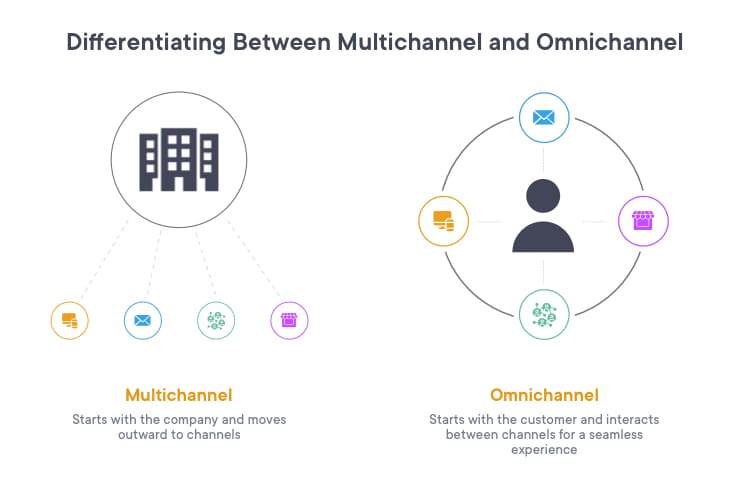
Channel-less customer experience
Providing a consistent customer experience across multiple channels without the customer having to switch between different channels is called a Channel-less customer experience. In a channel-less customer experience, customers interact with a company through various channels without repeating information or starting the process over. Customer experience is continuous and integrated, regardless of the medium used.
To achieve a channel-less customer experience, companies need to understand the customer journey clearly. They should design their interactions and processes with the customer in mind. It may involve implementing technologies like chatbots, AI assistants, and CRM systems that allow customers to move between channels without interrupting the experience.
The goal of a channel-less customer experience is to:
- Provide convenience and ease of use for the customer
- Improve efficiency and effectiveness for the company
A channel-less customer experience can lead to increased customer satisfaction and loyalty and improved business outcomes.
How is a channel-less experience different from an omnichannel experience?
Both channel-less and omnichannel experiences provide a seamless and consistent customer experience across multiple channels. However, the focus of a channel-less experience is on eliminating the need to switch between eCommerce platforms or channels to complete a task or get the information they need. In a channel-less experience, the customer can interact with a company through any medium, and the experience will be continuous and integrated, regardless of the specific channel being used.
Both omnichannel and channel-less experiences use technology and other strategies to create a cohesive and integrated customer journey. Still, the focus and goals of each approach are slightly different. Omnichannel experiences provide a consistent and seamless experience across multiple channels, while channel-less experiences eliminate the need for the customer to switch between channels.
Why is Omnichannel Important?
Just having satisfied customers isn’t good enough anymore. If you really want a booming business, you have to create raving fans.
– Ken Blanchard
Customers buy based on the experience they have with your brand. In today’s dynamic world of eCommerce, where brands and marketplaces are racing to grab consumer attention, building brand loyalty and making the brand stand out is a persistent exercise for eCommerce players.
CxOs acknowledge the fact that offering a seamless experience steers customer expectations, builds brand perceptions, and can make or break a business.
89% of customers will switch to a competitor if your brand doesn’t provide the customer experience they expect.
What are the Keys to Succeeding with an Omnichannel Strategy?
In today’s world, the omnichannel retail strategy is a norm among retailing businesses. But, sadly, not everyone is getting it right. This eMarketer report is proof:
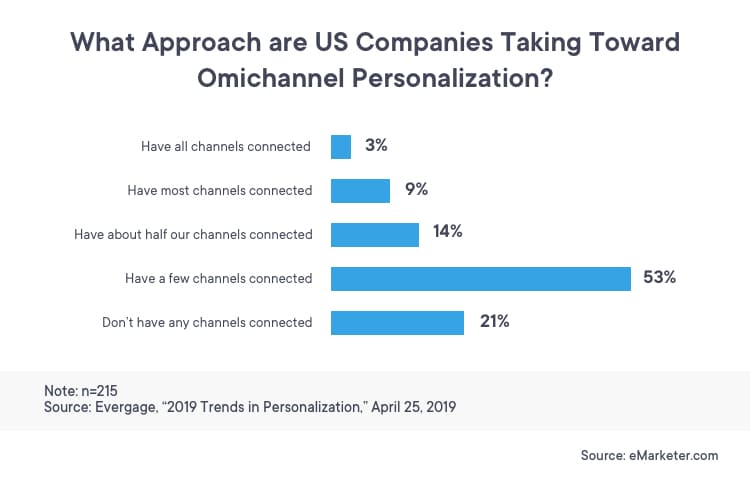
So, what stops them from getting the right omnichannel marketing strategy off the ground? Clearly, it is the lack of a foolproof strategy that will help create the difference.
Here is how you can improve your omnichannel retail strategy.
- Identify your Target Buyers/Customers Your omnichannel strategy will enhance the customer experience, for which you will have to know your customer, i.e., your target audience. Understand who your customers are and what are their expectations from you.
Start by creating buyer persona profiles using an online template. It is always a good idea to segment the buyer personas based on common factors, such as demographics, age, occupation, age, expectations, etc.
You can also leverage Google Analytics or your CRM software to gather all the essential data you need to create buyer profiles.
However, the lower the number of profiles you create, the easier it gets to infer essential information for creating a foolproof omnichannel strategy.
- Focus on Customer Journey Mapping Customer journey mapping for different buyer personas will help you track the path that your customers follow to perform an action on a website, app, or offline store. If they are abandoning at any point, what is it that puts them off?
To offer an orchestrated omnichannel experience, it is essential to understand the broken points in the flow of channels, and this can be easily identified with customer journey mapping.
Here’s what a customer journey map template looks like:
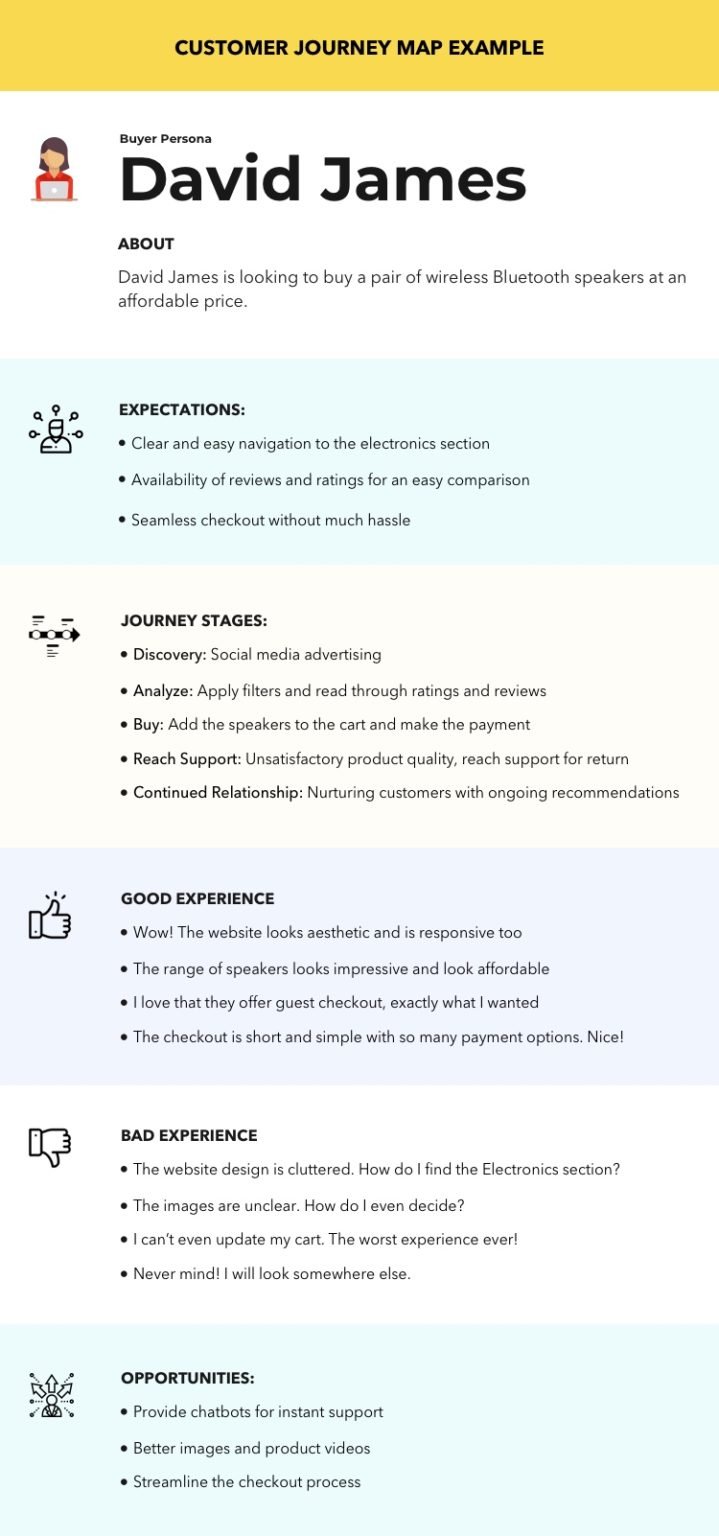
The bad experience section should be your focus point as this can help you understand, identify, and fix the broken pieces that restrict offering a connected experience across channels.
- Undergo a Thorough Competitive Analysis Understanding how your competitors are managing the omnichannel experience can be of great help. If a competitor is fairing well in the market and is recognized as an omnichannel brand, analyze what they are doing differently.
You should be able to identify:
- What is your competitor’s omnichannel strategy
- What are the gaps in your customer experience based on competitor analysis
Once you find the answers to these questions, it will get easy to match up to the customer expectations in a fast and effective manner.
- Use Smartphones as a Unifying Device Across Channels The majority of shoppers prefer using a smartphone for shopping online. So, as a part of your omnichannel strategy, make smartphones a hub that can redirect the customer to other touchpoints and channels.
For instance, a shopper enters your physical store with their smartphone. The integration of both platforms should be such that the shopper can use their device to navigate and shop around the store.
A good example of such integration is a cashierless store by Amazon, where a customer can use their app to locate and pay for the items using their smartphone.
- Proactive Customer Support Across Channels Customer support is a primitive form of strategy that every digital commerce business should adopt. For nailing omnichannel commerce, the need is to scale the customer support across all channels available.
If a customer is reaching out through Facebook Messenger, active customer support should be available. The same is the case for website and app support. Redirecting customers across channels for reaching out for support is not a recommended practice.
The right way to do it is to upscale customer support staff and invest in chatbots for Messenger and other channels. Also, support should be accessible through every means, i.e., emails, phone calls, chat, and DMs.
- Active Marketing Automation Across Channels and Touchpoints Your dedicated CRMs should enable marketing automation across channels. Every step across every channel and touchpoint needs to be tracked aggressively to look for opportunities for improvement.
This will help you identify user behavior across channels, which, in turn, will help improve customer experience across touchpoints. For instance, you’ll know how many newsletter subscribers you are gaining, how many purchases are happening, the number of customer visits across channels, etc.
Based on this data, you can then form a strategy for improving sales across channels with low traffic and traction and scale up marketing activities across channels that gain most of the eyeballs.
- Figure out Your Effective Communication Channels Companies use a long list of communication channels, but not all resonate with the target audience. Your omnichannel analytics will play a definitive role here. Do not waste your time and resources on some random channel that has never interested your customers. Instead, shortlist channels that your potential customers spend the most time on to move with the purchase.
Online was preferred for customer reviews (70%) and saving time (69%) whereas getting the product quickly (79%) and getting questions answered (51%) were considered in-store strengths.
– BookingBug
This finding clarifies that knowing your effective channels will help drive an omnichannel marketing strategy in the right direction. Tools like Google Analytics can help improve digital customer support by giving you insights into your audiences and the channels they use. Improve landing pages based on such suggestions.
Thus, it becomes easy to figure out which channels deserve the most attention for driving sales.
- Embed Voice Channels Across Touchpoints Being able to communicate with your customers 24/7 is an important sales, omnichannel strategy to bring revenues in the times to come. Where designing chatbots or virtual assistants play an essential role, indulging your customers with a real person should be given priority too. If your business fails to connect a customer to an executive in less than two minutes, you will likely lose big time.
75% of customers believe it takes too long to reach a live agent.
– Harris Interactive
Interacting with a real person across all the sales channels creates a sense of trust and confidence in the brand. That is not enough, though! You need to train your customer executives to aim for first contact resolution, which, in turn, makes for an effective omnichannel retail solution.
- Embrace BOPIS for an Improved Experience Buy Online, Pick-up in Store (BOPIS) is the new omnichannel strategy that should be implemented for an overall better experience. The following Forrester stats reveal the difference between customer expectations and the corresponding retail strategy.
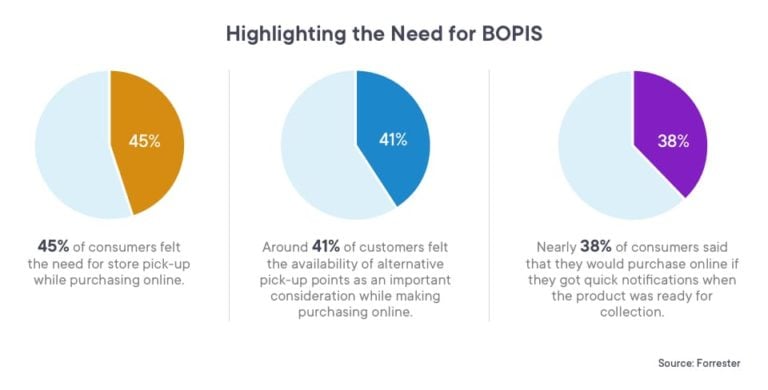
Therefore, managing an accurate in-store inventory should take a front seat so that your retail & eCommerce customer service falls right into place. Also, the salesperson should be aware of online and offline product availability.
This is possible if they have dedicated tablets or mobile devices to cross-check inventories. All in all, try to keep processes, technologies, and salespersons synchronized, or you’ll lose out on revenues.
- Take Advantage of Social Commerce
In 2018, an estimated 2.65 billion people were using social media worldwide, a number projected to increase to almost 3.1 billion in 2021.
– Statista
The above statistic shows that there is abundant data present on social media platforms. Thus importance should be given to collect this data to draw inferences about your customers with the best data visualization tools.
Also, make communication on social media platforms a priority as people consider friends’ reviews while making buying decisions.
Another omnichannel strategy is promotions in the form of carousel advertisements that help offer personalized user experience. Such recommendations can be provided by tracking customer behavior by linking their social media logins for websites and social media accounts such as Facebook.
What next, persuade your customers to buy there and then through Facebook Messenger instead of redirecting them to your eCommerce website.
- Cashier-less Checkouts Should Gain Momentum
Amazon is winning the game when it comes to implementing the omnichannel strategy. An example of one such disruption is their introduction of Amazon Go, which is one of a kind cashierless checkout system at their brick-and-mortar grocery stores.
They have moved one step ahead by eliminating the obligation to stand in queues for billing. This is the best omnichannel customer experience example. Have a look.
In the truest manner, this is an outstanding omnichannel retail strategy, and as a business, one must identify such propositions to enhance their customer experience. And, the probability of making profits will see an upsurge too. Just like it did for Jeff Bezos.
Amazon Go just made Jeff Bezos $2.8 B richer.
– Investopedia
Omnichannel Strategy Examples for Top 7 Brands
Here are some omnichannel strategy examples that showcase how successful brands are leveraging eCommerce trends to deliver seamless experience to their target customers:
- Nike
- About the Brand: An American multinational corporation engaged in the design, development, manufacturing, and worldwide marketing and sales of footwear, apparel, equipment, accessories, and services.
- Customer Experience USP: Bridging the online-offline gap
How Nike Delivers a Seamless Omnichannel Experience
Nike introduced the omnichannel experience back in 2006 with the launch of the Nike+ program that was executed in partnership with Apple. This collaboration allowed users to connect a pair of Nike sneakers with an iPod and track multiple things, including the running distance, time taken, and calories burned.
The data was synced to Nike+’s website that also helped create and bring together a digital community of athletes.
Here’s how the brand describes Nike+:
Connecting Nike’s wealth of sports knowledge with its footwear and apparel offerings, Nike+ translates the ‘plus’ to ‘personal,’ providing members with customized guidance, support, and a host of tailored resources that unlock the best of Nike.
A decade later, Nike+ turned into a customized app to incorporate all types of users as a part of their omnichannel marketing strategy. Its onboarding process includes questions around the users’ favorite Nike products, their preferred sports, and so on that subsequently help the brand personalize the users’ newsfeed.
Lesson You can Learn from Nike’s Omnichannel Strategy
Nike turned eCommerce challenges into an opportunity and offered digital customers access to shoes and gear, events, athlete stories, and running and training programs, Nike’s omnichannel selling strategy successfully bridges the online-offline gap and attempts to convert a casual visitor into a potential customer.
- Puma
- About the Brand: German multinational athletics brand
- Customer Experience USP: Mobile-first approach to digital commerce
How Puma Delivers a Seamless eCommerce Experience
According to the Salesforce Shopping Index Report, mobile accounts for 60% of traffic. However, in one of the case studies of Puma, mobile accounted for about 70% of traffic in a few demographics.
So to convert this high mobile traffic, Puma decided to optimize its site so that visitors could easily create accounts and save carts for future eCommerce checkouts on mobile and tablet.
This technological overhaul reduced the friction and improved the speed, agility, and mobile shopping experience for Puma’s customers, thereby improving the conversion from less than 1% to 1.5%.
Lesson You can Learn from Puma’s Omnichannel Strategy
In its omnichannel retail strategy, Puma has put its customers in mind and optimized the channel they prefer to use with its multi-touchpoint strategy and the mobile-first approach.
Moreover, Puma has also realized that mobile is no longer the future if you want to survive in this competitive environment. You have to serve an excellent experience for your customers on mobile now: 60% of traffic and 41% of online orders come from mobile.
The site is faster. The user experience is better, and the conversion rate is better. Full stop.
– Ken Kralick, Global Head of eCommerce, Puma
- Sephora
- About the Brand: A French multinational chain of personal care and beauty stores
- Customer Experience USP: Cross-platform channel experience
How Sephora Delivers a Seamless Omnichannel Experience
A prime example of how this cosmetic giant has seamlessly linked its online and in-store offerings is its cross-platform channel initiative, Happening at Sephora, which displays all the events, launches, and activities at the physical stores onto their digital channel.
Correspondingly, their in-store experience offers digital tools that draw the customers back to the digital channel.
Lesson You can Learn from Sephora’s Omnichannel Strategy
Sephora has introduced one of the best omnichannel solutions with several innovative approaches to capture data in the stores and use it for personalization online. This interesting method has its store staff collate the list of products tried by a client during a complimentary makeover only to digitally re-engage them later with those specific product-focused emails.
The beauty retailer has also partnered with Google to broadcast its video content on the Google Home Hub in-store to help users explore further with voice and visual assistance.
What’s more, shoppers can get a 3D live experience on the Sephora Virtual Artist app by uploading an image and experimenting with their looks by virtually trying Sephora’s range of makeup products.
- Steve Madden
- About the Brand: America’s hottest footwear brand for men and women
- Customer Experience USP: Cross-channel Data Analytics
How Steve Madden Delivers a Seamless eCommerce Experience
Although 80% of Steve Madden’s revenue comes from wholesale, they still find it vital to invest their time and budget in its eCommerce business.
Steve Madden’s omnichannel strategy relies heavily on ‘data’ to deliver a frictionless eCommerce experience to their potential customers. Their main aim is not just to collect data but also act upon that data and communicate with their customers in meaningful ways.
Steve Madden has incorporated CRM in its eCommerce strategy to combine its cross-channel data and cover it with the layers of business intelligence. This enables them to segment customers and builds more meaningful, targeted communications.
Lesson You can Learn from Steve Madden’s Omnichannel Strategy
No matter where your brand stands in the race of eCommerce development, in today’s phygital world, it is essential for retailers to capture information of customers and use it effectively to match up to their activity whenever they shop.
A Forrester survey reveals that 72% of brands believe they can use analytics reports to improve the customer experience.
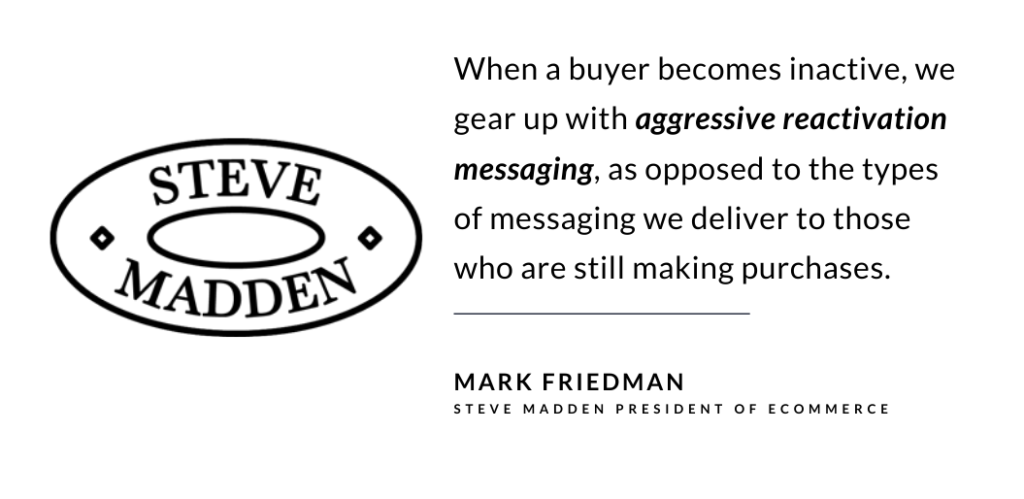
- Timberland
- About the Brand: American manufacturer and retailer of footwear
- Customer Experience USP: Merging the physical and digital worlds of eCommerce
Timberland’s Omnichannel Strategy
Timberland builds a connective customer experience by effectively making use of Near-Field Communication (NFC) technology to amalgamate the two worlds of eCommerce: physical and digital.
NFC allows secured information to be instantly transferred between mobile devices without interference, thereby solving two of the biggest retail issues: time and convenience.
With “Touch Walls” implemented, along with tablets, customers do not have to seek help from a store manager to find more information about the desired product. As customers continue to look up different products, the tablets’ personalization software starts to make similar product suggestions to the customer based on their purchasing history.
Lesson You can Learn from Timberland’s Omnichannel strategy
Bringing the physical and digital worlds of eCommerce close to each other is a unique way to store customers’ profiles and use them to hone your retail and remarketing digital commerce strategy continually.
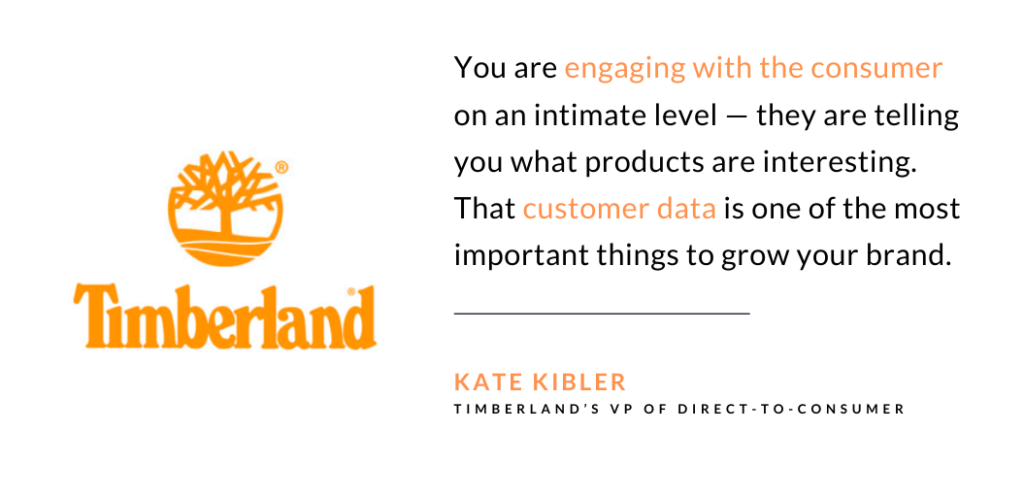
- IKEA
- About the Brand: A Swedish multinational group that designs and sells ready-to-assemble furniture, kitchen appliances, and home accessories
- Customer Experience USP: Emerging technology-driven application
How IKEA Delivers a Seamless Omnichannel Experience
IKEA’s Planning Studio stores are a star feature of the Swedish furniture retailer’s omnichannel experience. These stores are small appointment-based spaces specifically for the urban customers who may not be able to visit the warehouse that’s mostly located on the city outskirts.
When customers visit these stores, they are assisted by experts with tips on furnishing their homes using 3D planning tools. Products that are ordered get eventually shipped from the warehouses nearby that have stored them to ensure a quick delivery.
Lesson You can Learn from IKEA’s Omnichannel strategy
IKEA’s AR app, one of the key components of their omnichannel strategies, lets customers visualize furniture in the comfort of their homes, thus blurring the line between the online and physical store experience.
IKEA offers pick-up and order points as well through which online shoppers can pick their products from centers close to where they live.
- L’Oreal
- About the Brand: French personal care company headquartered in Clichy
- Customer Experience USP: Personalized, uninterrupted journeys
How L’Oreal Delivers a Seamless eCommerce Experience
The customer is the top priority for this global beauty leader and sits in the top position of their omnichannel strategy. L’Oreal combines rich customer data with Artificial Intelligence (AI) to engage its customers across their buying journeys, social media, and its eCommerce sites, delivering a personalized experience at scale.
By engaging customers into a unique, integrated, end-to-end shopping journey, L’Oreal has managed to increase its revenue by 48.5%.
Lesson You can Learn from L’Oreal’s Omnichannel Strategy
A personalized, uninterrupted journey is vital to convert visitors into customers and customers into loyal customers irrespective of the industry. In the end, 84% of customers believe that being treated like a person, not a number, is very important to winning their trust.
Omnichannel Retail Trends
Here are the omnichannel retail trends:
- Online Coupons, Offline Shopping Buyers will be able to utilize the online discount coupons in a brick-and-mortar store, and vice-versa.
- Offline Mobile Devices Setting up mobile devices across physical stores is the new in. A buyer can look for the product online if not found in the offline store, read through reviews, and go for a virtual try-on too.
- Social Integration Influencer and social media retailing will be gaining traction. Buyers wouldn’t be redirected to the website from a social media platform advertisement as the checkout process will be completed on the social media platform itself.
- BOPIS and BORIS Where BOPIS stands for “buy online pick-up in-store,” BORIS stands for “buy online return in-store.” This omnichannel strategy is already in practice and will be gaining more momentum.
- Availability Notifications (Online and Offline) If a buyer cannot find a product online, the channel will provide information about the product’s in-store availability. Moreover, the customer will be able to book the product before they head to the offline store.
Conclusion
Organizations aiming for an omnichannel transformation must offer customers a consistent, personalized, and seamless experience. It is equally important to build an omnichannel strategy that best works specifically for your eCommerce business model while finding optimum ways to keep your customers consistently engaged.
By embracing and implementing the omnichannel strategy, you will be able to bridge the gap between online and offline channels. Not only will you gain brand recognition, but your revenues and the omnichannel customer experience will witness a positive impact too.
There might be financial or technical challenges, but your omnichannel efforts will surely pay off in the long run. An eCommerce expert consultant can easily guide you through the best practices for implementing omnichannel while your regular business processes stay unharmed.
Apart from developing a long-standing relationship with your customer, omnichannel experience is probably the only way for businesses to address the rising competition, provide excellent customer engagement, and ensure better revenues.
SHARE THIS POST
Table of Contents
Related Services
Related Resources
- eCommerce App Development Cost: Budgeting In-Depth Guide
- 13 Differences Between B2B and B2C eCommerce Websites
- Top 10 eCommerce Challenges and Easy Ways to Overcome Them
- 3 Types of eCommerce Business Models That Work in 2025
- eCommerce for Business: Is eCommerce Applicable for All Business Types
- eCommerce Customer Journey Mapping - The Secret to Higher Conversion Rates
- What is Headless Commerce? The Ultimate Guide
- Top 15 eCommerce KPIs to Track the Performance of Your Online Business
- Why Your Business Needs a Mobile eCommerce App
- Omnichannel vs Multichannel Retailing: The Complete Guide
- What is eCommerce Order Fulfilment? (And 6 Steps to Improve the Process)
- PCI Compliance: Everything You Need To Know
- The BEST Guide to eCommerce Personalization
- 12 Essential Factors for Choosing the Best eCommerce Platform
- The Ultimate Guide to Product Information Management (PIM) Systems for Ecommerce
- What is a Product Recommendation Engine (And How it Helps Boost Sales)
- eCommerce Replatforming: Challenges, Benefits, and Best Practices
- The Ultimate Guide to eCommerce Security
- Top 13 eCommerce Trends in 2025
- How Voice Search will Transform the Future of eCommerce
- What is Web Accessibility (And Why it Matters for Your eCommerce Business)

